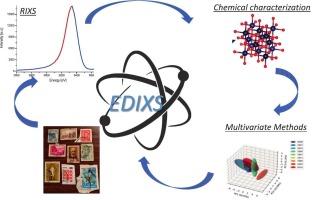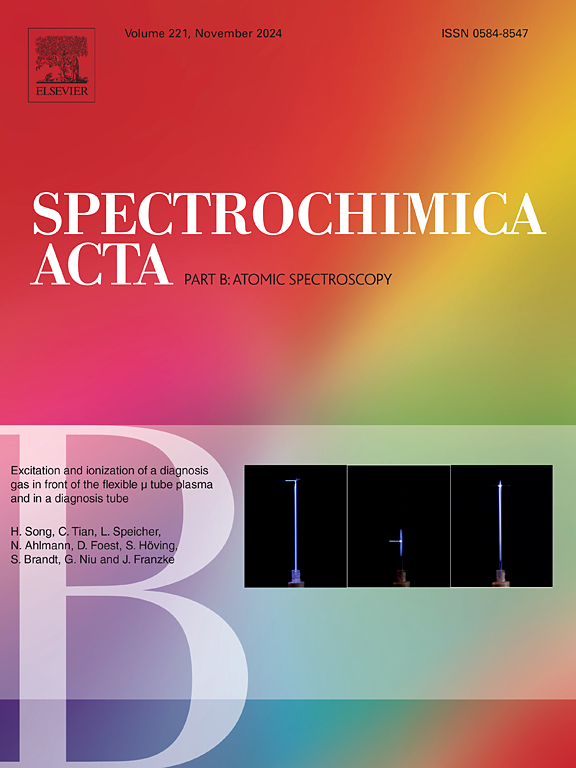利用能量色散非弹性x射线散射(EDIXS)分辨邮票:区分元素成分以外的油墨
IF 3.8
2区 化学
Q1 SPECTROSCOPY
引用次数: 0
摘要
由于邮票潜在的经济价值和历史价值,鉴定邮票至关重要。由于能量色散非弹性x射线散射(EDIXS)光谱能够识别原子环境和氧化态,因此本研究探讨了其在不同邮票之间区分的功效。虽然传统的x射线荧光(XRF)加上主成分分析(PCA)可以区分邮票,但它的信息主要反映的是墨水和纸张的成分,这些成分随着时间的推移而变化,并不是正确分类的理想选择。本研究分析了近一个世纪以来阿根廷九枚邮票中的铁Kα-RIXS峰区。将PCA应用于EDIXS数据,揭示2D和3D主成分表示中的不同区域,其中每个区域对应于取消标记墨水的特定元素组成和原子环境。虽然有些区域重叠,但有几种油墨明显不同,这突出了EDIXS区分油墨的潜力。由于区域重叠,目前发现的局限性可以通过进一步的调查来解决,包括增加每个点的测量和邮票之间的直接比较。总的来说,这项研究强调了EDIXS在表征和区分元素成分以外的油墨方面的力量,为邮票认证和打击集邮中的伪造提供了一个有前途的潜在工具。本文章由计算机程序翻译,如有差异,请以英文原文为准。

Discrimination of postal stamps via energy-dispersive inelastic X-ray scattering (EDIXS): Differentiating inks beyond elemental composition
Authenticating postal stamps is crucial due to both their potential financial and historical value. This study explores the efficacy of Energy-Dispersive Inelastic X-Ray Scattering (EDIXS) spectroscopy for discriminating among different stamps, due to its ability to discern atomic environments and oxidation states. While conventional X-ray fluorescence (XRF), coupled with Principal Component Analysis (PCA), can differentiate stamps, its information primarily reflects ink plus paper composition, which varies over time and isn't ideal for a proper classification.
This study analyzes the iron Kα-RIXS peak region in nine Argentine stamps spanning nearly a century. PCA is applied to the EDIXS data, revealing distinct regions in 2D and 3D principal component representations, where each region corresponds to a specific elemental composition and atomic environment of the cancellation mark inks. While some regions overlap, several inks are demonstrably differentiated, highlighting the potential of EDIXS for discriminating inks.
The limitations of the current findings, due to overlapping regions, can be solved with further investigations including increased measurements per point and direct comparisons among stamps. Overall, this study underscores the power of EDIXS in characterizing and distinguishing inks beyond elemental composition, offering a promising potential tool for stamp authentication and combating forgery in philately.
求助全文
通过发布文献求助,成功后即可免费获取论文全文。
去求助
来源期刊
CiteScore
6.10
自引率
12.10%
发文量
173
审稿时长
81 days
期刊介绍:
Spectrochimica Acta Part B: Atomic Spectroscopy, is intended for the rapid publication of both original work and reviews in the following fields:
Atomic Emission (AES), Atomic Absorption (AAS) and Atomic Fluorescence (AFS) spectroscopy;
Mass Spectrometry (MS) for inorganic analysis covering Spark Source (SS-MS), Inductively Coupled Plasma (ICP-MS), Glow Discharge (GD-MS), and Secondary Ion Mass Spectrometry (SIMS).
Laser induced atomic spectroscopy for inorganic analysis, including non-linear optical laser spectroscopy, covering Laser Enhanced Ionization (LEI), Laser Induced Fluorescence (LIF), Resonance Ionization Spectroscopy (RIS) and Resonance Ionization Mass Spectrometry (RIMS); Laser Induced Breakdown Spectroscopy (LIBS); Cavity Ringdown Spectroscopy (CRDS), Laser Ablation Inductively Coupled Plasma Atomic Emission Spectroscopy (LA-ICP-AES) and Laser Ablation Inductively Coupled Plasma Mass Spectrometry (LA-ICP-MS).
X-ray spectrometry, X-ray Optics and Microanalysis, including X-ray fluorescence spectrometry (XRF) and related techniques, in particular Total-reflection X-ray Fluorescence Spectrometry (TXRF), and Synchrotron Radiation-excited Total reflection XRF (SR-TXRF).
Manuscripts dealing with (i) fundamentals, (ii) methodology development, (iii)instrumentation, and (iv) applications, can be submitted for publication.

 求助内容:
求助内容: 应助结果提醒方式:
应助结果提醒方式:


